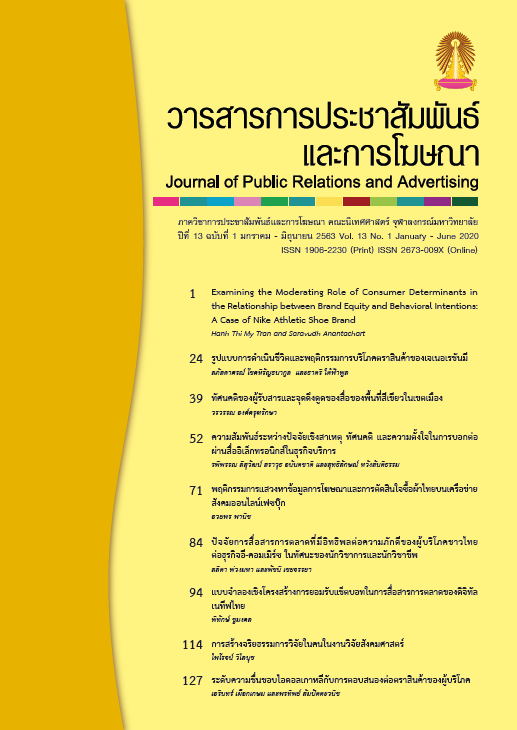Audiences’ Attitudes and Media Appeals of Urban Green Spaces
Main Article Content
Abstract
This research aims to study audiences’ attitudes towards appeals of green spaces’ media and provide a guideline for content creation to match target audiences’ needs and levels of awareness about environmental problems. This quantitative research was conducted in August 2018 by a survey of four hundred samples who lived in Bangkok. The research found that there were 38 samples, or 9.50%, who thought that environmental problems were not their concern (less conscious) while 362 samples, or 90.50% of all participants thought that environmental problems were critical (more conscious). Also, the samples had positive attitudes towards two kinds of appeals; sick baby appeal and well baby appeal. The research’s analysis by demographics showed that, although people were different in gender and education, they had attitude towards the two kinds of appeals in the same way. But the samples with different ages had attitude towards the two kinds of appeals in the different way. Finally, from hypothesis testing about the samples’ attitude toward two kinds of appeals, the results showed that there was no statistically significant difference between two groups of audience who had low and high level of environmental consciousness.
Article Details
References
กิตติพงศ์ จิรวัสวงศ์. (2555). ISO 14063 การสื่อสารด้านสิ่งแวดล้อม. วันที่เข้าถึงข้อมูล 12 กุมภาพันธ์ 2561, แหล่งที่มา http://www.tpa.or.th/publisher/pdfFileDownloadS/qm171_p017-20.pdf
คนไทยยุคดิจิทัลขยับสู่โลกออนไลน์. (2561, 26 กรกฎาคม). โพสต์ทูเดย์.
นรีรัตน์ งามประดิษฐ์. (2553). ประสิทธิผลของการใช้ภาพและข้อความที่สร้างความกลัวในการรณรงค์เพื่อลดภาวะโลกร้อน. วิทยานิพนธ์ปริญญามหาบัณฑิต สาขาวิชาการประชาสัมพันธ์ จุฬาลงกรณ์มหาวิทยาลัย.
ปิยวรรณ ศรีอ่อนจันทร์. (2560). การรับรู้ และทัศนคติของเจเนอเรชั่นวายต่อการประชาสัมพันธ์ผ่านสื่อออนไลน์ของโครงการ “เที่ยวไทยเท่”. โครงการวิชาชีพ ปริญญามหาบัณฑิต สาขาวิชานิเทศศาสตร์ จุฬาลงกรณ์มหาวิทยาลัย.
วิเชียร เกตุสิงห์. (2534). คู่มือการวิจัย การวิจัยเชิงปฏิบัติ. กรุงเทพมหานคร: (ม.ป.พ.)
สื่อโซเชียลไทยบูม เฟซบุ๊ก-ทวิตเตอร์ฮิต. (2561, 17 กรกฎาคม). โพสต์ทูเดย์.
เสน่ห์อีคอมเมิร์ซไทย แรงดึงดูดยักษ์ต่างชาติ. (2561, 26-29 กรกฎาคม). ประชาชาติธุรกิจ.
อิทธิพัทธ์ ปิ่นระโรจน์. (2561, 25 มกราคม). มลพิษกลางกรุงเทพฯ ฝุ่นพิษ PM2.5 ทำไมใครก็ว่าร้าย!. วันที่เข้าถึงข้อมูล 2 กุมภาพันธ์ 2561, แหล่งที่มา http://www.nationtv.tv/main/content/378598679/
ภาษาอังกฤษ
Fournier, G. (2018). Resistance. Psych Central. Retrieved October 10, 2018, from https://psychcentral.com/
encyclopedia/resistance/
Mass communication theory: Spiral of silence. Retrieved October 10, 2018. from https://masscommtheory.
com/theory-overviews/spiral-of-silence/
Meisner, M. (2015). Environmental communication: What it is and why it matters. Retrieved from https://theieca.org/resources/environmental-communication-what-it-and-why-it-matters
Obermiller, C. (1995). The baby is sick/the baby is well: A test of environmental communication appeals. Journal of Advertising. 24(2), 55-70.
Ongkrutraksa, W. (2005). Environmental communication in the digital age: A study of emotional appeal effects. Retrieved from http://www.bu.ac.th/knowledgecenter/epaper/jan_june2005/worawan.pdf
Ongkrutraksa, W. (2007). Effectiveness of emotional appeals in environmental advertising. Doctor of Arts Dissertation, Faculty of Arts, Tokai University.
Ongkrutraksa, W. (2017, August 4). Communications for sustainable urban green space: A review of the literature. GSCM NIDA 2nd International Conference on Innovative Communication and Sustainable Development in ASEAN (ISDA) August 4, 2017 Bangkok (Thailand).


